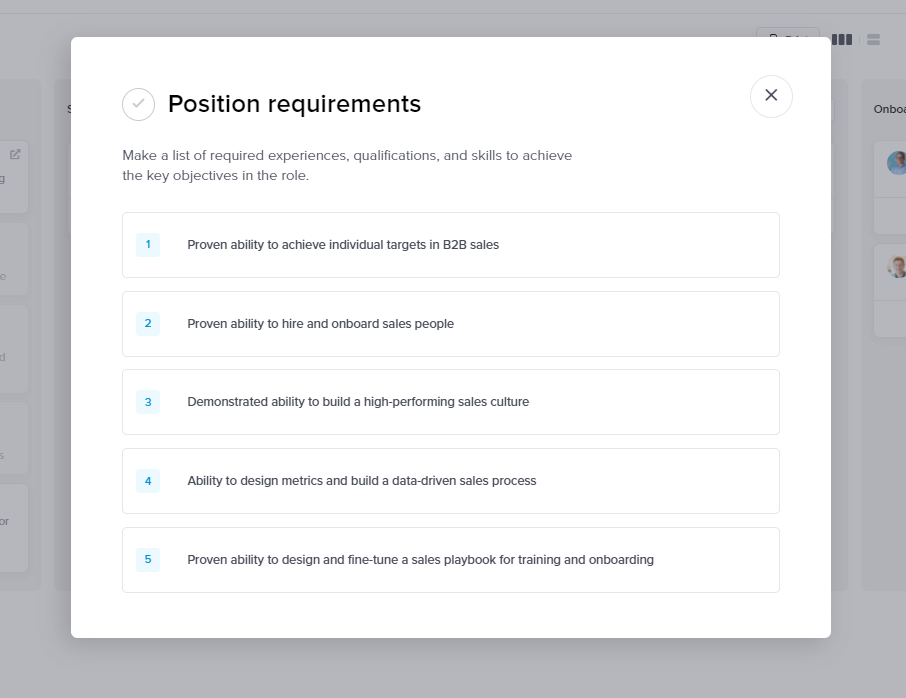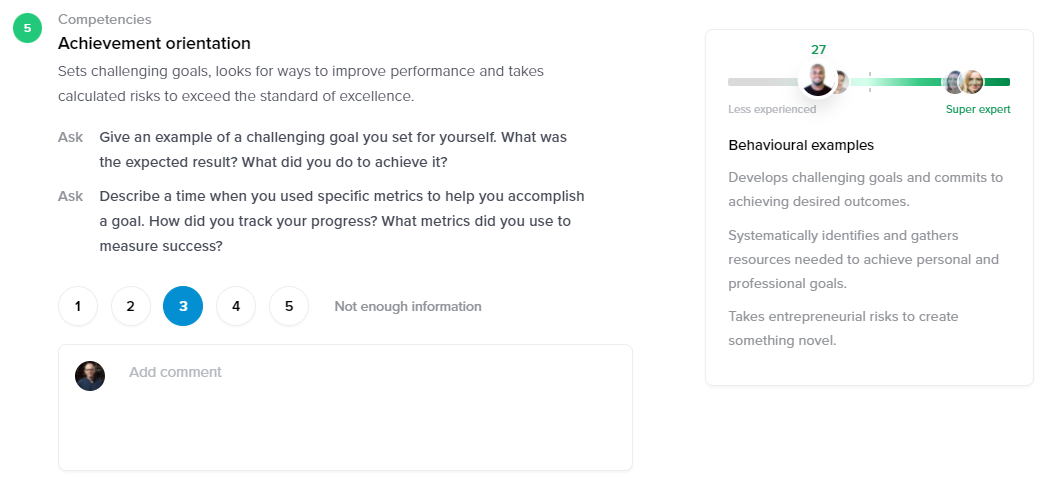After 30 years of hiring as a headhunter, I’ve concluded that hiring decisions are the worst managerial decisions to have to make. They’re expensive decisions, for starters, usually made without much training. And do you know any other high-impact decisions that are based primarily on gut feeling? Without data to support them?
Looking at actual hiring and firing data only confirms my conviction. A study analyzing 20,000 new employees in over 300 public and private organizations found that 46% of newly hired employees failed within 18 months of being hired.
Dysfunctional management folklore tells us to “hire fast, fire fast.” But like most important decisions, hiring decisions should be made slowly.
A better hiring process
Research about hiring practices and results has shown that using a structured hiring process leads to better hiring outcomes. In a nutshell, the research boils down to the following data-backed hiring process:
-
Define clear hiring criteria
-
Measure each criterion separately using reliable methods
-
Summarize assessment results
-
Hire the candidate with the highest score
In the real world, the process includes extra steps like sourcing, screening, checking references, and so on. We’ll dig into all of that. Think of this as an exhaustive guide to hiring based on research—and my own 30-year experience.
1. Defining the role

In my line of work, a clear understanding about the person I’m looking for is perhaps the most important part of the job. A world-class hiring and interviewing process will not save you when you start working with the wrong assumptions.
I’ve had plenty of meetings with executives only to realize that the initial brief, often prepared by HR, doesn’t clearly reflect the wishes and understanding of the hiring managers.
Defining the role is a three-step process:
-
Define position-specific key performance indicators (KPIs)
-
Define basic or threshold criteria
-
Define position-specific competencies
The first step in analyzing the position is defining position-specific KPIs. For example, three things you want the person to achieve during the first year. If you don’t know or are unsure what to include, interview a couple of successful people in similar roles and make up your own mind about your needs.
With the KPIs set, the next step is defining the basic or threshold criteria. These are things that can be verified easily and cannot be learned in days. For example, use of a specific programming language, along with the usual suspects like work and management experience.
After defining the basics, you need a way that helps you differentiate the best from merely good candidates. Best practice suggests using competencies (behaviors or thought processes that lead to superior job performance) for this. There are many types of competency models, some so sophisticated you need a trained professional to use them, with others that can be used by a manager without prior training or experience.
2. Sourcing
Once you have clarity on who exactly you’re looking for, the next step is to define your search strategy: how are you going to find prospects?
Use every tool and resource available. Think LinkedIn (750+ million professional users which you can source on free), different professional and trade organizations, your own network, the social networks of your employees, advertised recruitment, and anything else you can think of.
At this early stage, the name of the game is finding people that could qualify for the role, even if they’re not actively looking. Most professionals are “passive”: they don’t apply to job ads, but they’re usually happy to talk to a headhunter and often consider new opportunities.
3. Screening
If you’ve built a long list, say over 50 people, it doesn’t make sense to start the interview process with everyone on the list. Many of them probably aren’t interested or willing to meet at all, and with some who are willing to, they might not seriously consider the position. On the other side of the coin, you don’t want to start the process with someone whose compensation requirements don’t line up with yours.
But you can’t know that until you talk to them, so do a short screening interview, usually over the phone, to decide if it makes sense to take time for a formal interview. A common mistake I’ve seen from inexperienced researchers and headhunters is jumping to conclusions if the prospect doesn’t reply to the request for a screening. For example: LinkedIn is the most abused professional social network, so many people don’t check their LinkedIn mailbox or have it connected to their personal inbox. If you haven’t actually talked to a prospect, you can’t really know if they’re interested.
So find a way to reach as many people from your list as possible and ask for a quick call. The aim of the first contact is to understand if the prospect is open to job opportunities, could qualify, and would be ready to move on with the process.
4. Job-fit meetings
The first real interviews are often held by an external headhunter or internal talent acquisition professional. In a smaller company, it might be the hiring managers who do it all by themselves.
What you’re aiming for at these meetings is clarity on three questions:
-
Does the candidate understand the business, the role you’re hiring for, and the expectations you have for them?
-
Is the candidate is a possible fit with your opening? And if so, to what extent?
-
To what extent do the candidate’s expectations line up with what you can possibly offer?
Focus and clarity are crucial here. Remember why you’re having the meeting, and spend time on nothing else. If you’re sure that you have answers to all the questions above, ask if there are any questions the candidate wants to ask you. When you end the call, be sure to tell the candidate when to expect to hear from you again.
5. Decision-maker interviews

In most cases, important hiring decisions are made jointly by two or more managers who typically meet somewhere between three and five finalists.
Remember, more interviews are not always better. What would you ask during the third interview that you haven’t already learned in the previous two? If you really keep learning new and relevant information during the third or even fourth interview, then something might be wrong with your process.
I’ve written a whole other article on decision-maker interviews, but here are my top tips for interviewing:
-
Have a set structure and questions for the interview, and follow the same structure with all candidates.
-
Only ask questions that enable you to evaluate candidates against your requirements. Questions about hobbies or brain-teasers are mere waste of time.
-
If you want to involve several people in the decision-making, use a panel interview: one person takes the lead and asks all the questions while others observe and make their evaluations according to the pre-agreed form.
-
Use a standard evaluation sheet corresponding to the questions asked.
-
Ensure that after every interview, all interviewers fill in the evaluation sheet before any discussion occurs.
At Teamscope, we evaluate candidates based on position requirements, competencies, unique traits, behavioral characteristics, and team fit. Each section is separately assessed and scored on a five-point Likert scale.
6. Testing the candidates
During my first years as a headhunter, I firmly believed in psychometric testing. Like many people with a psychology background in the search business, I was sure that this is the way to make hiring decisions more professional.
Today, I’m convinced that the testing mostly just reduces anxiety for the hiring manager. Knowing that “we did everything we could” makes a hiring manager feel better—it doesn’t actually help make better hiring decisions.
For example, what would you do with the information that one person is more social/extroverted than the other? Would the former make a better salesperson? Not necessarily. Would a more intelligent person make a better employee? Statistically, yes, but in concrete cases, you can’t be sure that a 10% difference in abilities makes the person with a higher score more likely to succeed.
Besides, research shows us that whenever hiring goes wrong, the main reason is a misfit between the team and the new employee—something that can’t be measured by testing candidates.
This is part of the reason we started Teamscope: to help hiring managers take into account the team fit of personalities and values and combine these data with the hiring manager’s evaluations of candidates’ competencies and experience.
When it comes to skills testing, they can and should be used for evaluating the level of a particular skill, like a coding test for a coder or an editing task for an editor. Still, be aware that headhunted candidates, the ones who have not applied for the vacancy but were approached by you, might be reluctant to do those kinds of tests.
7. Checking references
Checking references only helps if you ask very specific questions about the qualities you want to verify. Any questions about overall candidate evaluation aren’t that helpful, and in fact, can lead to bad decisions.
I had a frustrating experience once when a hiring executive called up previous bosses of a shortlisted candidate and asked them to rate the candidate from 1 to 10. He declined the candidate because they didn’t get any 10s. Another executive declined a favorite candidate based on someone’s opinion that “the person didn’t fit our culture.” The executive thought that, as our culture is similar to theirs, the candidate probably wouldn’t fit in with us either.
In short: ask for facts, and make your own conclusions from there.
8. Making the hiring decision
When making the final hiring decision, it’s good to have all the evaluation results together in a single table, including the information gained from checking references.
We use a dashboard that shows all candidates together with their combined scores from all evaluators. Whenever evaluation scores differ a lot—for example, two points apart on one hiring criterion between evaluators—we mark that down and talk with the involved evaluators separately.

One way to go is to simply hire the person with the highest score. But there are situations where choosing between similarly high-scoring candidates is hard.
In those cases, it’s ok to use your gut feeling about a candidate as a guide—but only after going through the process and data. Kahneman’s research I mentioned before shows that gut feeling alone is a bad indicator of success, but its predictability rises when combined with a structured process and evaluation.
In the end, the hiring decision is one of these lonely decisions that executives (or hiring managers, depending on the company) have to make on their own. Consider all the pros and cons, take into account all the advice of your colleagues, and then make your own decision. Take your time—don’t rush.
Offer not accepted?
This happens sometimes. Usually, it means that something went wrong in the earlier stages of the process, during the first qualifying interview or the first personal interview. At that point, you should end up with a clear understanding of the match of your potential offer and the candidate’s expectations. Keep in mind that a declined offer is almost always a lost case, even if replaced with an improved one later—so you want to make your best offer right away.
Of course, sometimes there are competing offers. Try to learn about these in as much detail as possible.
9. Onboarding
Hiring is only complete and successful after the new employee is fully onboarded: that means that the employee fully understands their job and what is expected from them, has a clear plan of action, and is fully integrated into the existing team.
If a new hire leaves within a year, it might signal a hiring mistake or an insufficient onboarding process—both of which should be taken seriously.
This was a guest post by Ott Niggulis, a marketer at Teamscope. Using a combination of behavioral science and machine learning, Teamscope offers decision tools for hiring, succession planning, and developing high-performing teams. With Teamscope, everyone can be an HR professional and bring clarity to the most complex hiring decisions. Want to see your work on the Zapier blog? Read our guidelines, and get in touch.
[adsanity_group align=’alignnone’ num_ads=1 num_columns=1 group_ids=’15192′]
Need Any Technology Assistance? Call Pursho @ 0731-6725516







